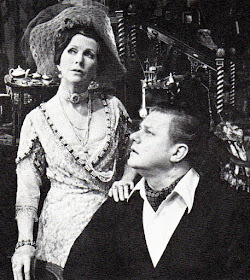 |
| Julie Harris, Charles Durning. |
The following precedes each entry
"In Lieu of Reviews"
Around 40 years ago, I began a major project that eventuated in the
publication of my multivolume series, The Encyclopedia of the New York
Stage, each volume covering a decade. For some reason now lost to the sands
of time, I chose to start with the 1970s. After writing all the entries through
1975 and producing a typed manuscript of 1,038 pages my publisher (Greenwood)
and I decided it would be best to commence with the 1920s. So the 1970-1975
material was put aside as I produced volumes for 1920-1930, 1930-1940, and
1940-1950. With those concluded, Greenwood decided it was all too expensive and
not sufficiently profitable, so the remaining volumes were cancelled, leaving
my 1970s entries in limbo.
To compensate, I used the research I’d done on the 1970s to write a
book for Greenwood called Ten Seasons: New York Theatre in the
Seventies, which described all aspects of that era’s theatre, onstage and
off. Many years later, in 2012, I began a postretirement “career” as a theatre
reviewer, which led to my creating this blog as an outlet for my reviews. Over
the past eight years or so I’ve posted nearly 1,600 reviews, a substantial
number having first appeared on other websites: Theater Pizzazz, The Broadway
Blog, and Theater Life.
Now, however, with the New York theatre in suspension, and my
reviewing completely halted, is probably the perfect time to post as many as
possible of the entries I prepared for the never-published 1970-1975 book. The
entries that follow are in alphabetical order. Each entry has a heading listing
the subject categories of the work described: the author (A), the director (D),
additional staging (ADD ST), when credited; the producer (P), the set designer
(S), the costume designer (C), the lighting designer (L), the source (SC), the
theatre (T), the dates of the run, and, in parentheses, the length of the run.
The original entries also contained the names of all the actors but I’ve
omitted those here.
In addition to the shows chronicled here, the New York professional
theatre produced hundreds of others, largely in the form of showcases receiving
brief runs of a dozen or less performances, most of them unreviewed. Their
credits and other significant data can be found in sources such as the annual
series called Theatre World and The Theater Yearbook: The Best Plays of . .
.
I will try to post at least one entry daily. When time allows, I’ll
provide more. The manuscript exists on fading, fragile paper and, because no digital
files exist, must be retyped. Hopefully, the tragic health situation we’re all
enduring will abate before I get too far into posting these entries but, for
the time being, devoted theatre lovers may find reading these materials
informative.
 |
| Charles Durning, Julie Harris. |
THE AU PAIR MAN [Comedy/Irish/Political/Two-Characters]
A: Hugh Leonard; D: Gerald Freedman; S: John Conklin; C: Theoni V. Aldredge; L:
Martin Aronstein; P: New York Shakespeare Festival Lincoln Center; T: Vivian
Beaumont Theatre; 12/27/73-1/27/74 (37)
The
second play produced at Lincoln Center under the Public Theatre regime of
Joseph Papp was this Irish comedy, originally seen in London in 1968. It was
accorded only mild approval, which owed more to the achievement of its starry,
two-actor cast than to the quality of its dramaturgy.
An
allegorical comedy, it presented Julie Harris as Mrs. Elizabeth Rogers, a
wealthy London dowager in whose crumbling home, laden with odds and ends redolent
of the British Empire, the play takes place. When a burly Irishman named Eugene
Hartigan (Charles Durning) comes to receive payment for a room divider that is
serving to shore up the walls, he is cajoled by the doughty Mrs. Rogers into
remaining as her “au pair man.” Under her Pygmalion-like tutelage, he gradually
drops his untutored ways to become the very model of a proper English
gentleman.
The
playwright’s notion is to suggest through political allegory that Mrs. Rogers
represents Great Britain, Hartigan the Irish Republic, and the home the
declining British Empire.
The
didactic hints were laid on rather broadly, and the author’s lack of subtlety
in developing them for his vaguely satirical purposes was generally scoffed at.
The schematic structure did give way occasionally to amusing banter and bits of
fun in the staging but without the excellently conceived John Conklin set, with
its multitude of Britannia bric-a-brac, the finely honed comic performances of
Harris and Durning, and the “unerring style” (Clive Barnes) of Gerald Freedman’s
direction, the production, like the house in which it’s set, would likely have
fallen apart.
Despite
its tepid reception, The Au Pair Man landed
a Tony nomination for Best Play. Harris was nominated for Best Actress in a
Play, Conklin for Best Scenic Designer, and Aldredge for Bes Costume Designer.
Previous entries:
Abelard and
Heloise
Absurd Person
Singular
AC/DC
“Acrobats”
and “Line”
The Advertisement/
All My Sons
All Over
All Over Town
All the Girls Came
Out to Play
Alpha Beta
L’Amante Anglais
Ambassador
American Gothics
Amphitryon
And Miss Reardon
Drinks a Little
And They Put
Handcuffs on the Flowers
And Whose Little
Boy Are You?
Anna K.
Anne of Green
Gables
Antigone
Antiques
Any Resemblance to Persons Living or Dead
Applause
Ari
As You Like It
Augusta
